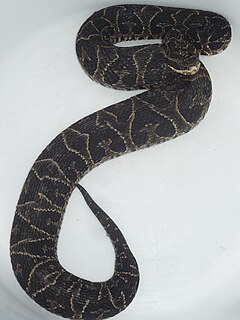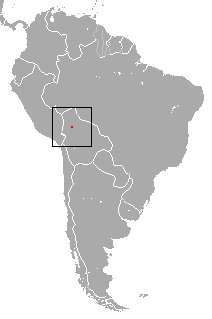 W
WThe white-black tree frog is a species of frog in the family Hylidae endemic to Bolivia. Its natural habitats are subtropical or tropical moist montane forests, subtropical or tropical high-altitude shrubland, subtropical or tropical high-altitude grassland, and rivers. It is threatened by habitat loss.
 W
WThe Charuplaya tree frog is a species of frog in the family Hylidae endemic to Bolivia. Its natural habitats are subtropical or tropical moist montane forests, rivers, and canals and ditches.
 W
WBothrops jonathani, known commonly as Jonathan's lancehead or the Cochabamba lancehead, is a species of venomous snake, a pit viper in the family Viperidae. The species is endemic to South America.
 W
WCochranella nola is a species of frog in the family Centrolenidae, the glass frogs, so named because of the transparent skin on the underside of the abdomen through which the internal organs can be seen. This species is endemic to Bolivia where it is found in the Andean foothills in the Santa Cruz Department. Its natural habitats are subtropical or tropical moist montane forests and rivers. The scientific name nola is Latin for "small bell", and refers to the high-pitched, bell-like call of the male in the breeding season.
 W
WDendropsophus arndti is a species of "clown tree frogs" described in 2017 that lives in the Amazon basin of Bolivia. The specific name arndti honors professor Rudolf G. Arndt, in recognition of his financial support for research and nature conservation.
 W
WEunectes beniensis is a boa species known only from the northeastern parts of Bolivia.
 W
WGastrotheca splendens is a species of frog in the family Hemiphractidae. It is endemic to Bolivia. The only precisely known record is from the eastern slopes of the Andes in the Amboró National Park, in the Santa Cruz Department. Only two specimens are known. Common name Schmidt's marsupial frog has been coined for this species, in reference to Eduard Oscar Schmidt who described the species.
 W
WThe Bolivian red howler is a species of howler monkey, a type of New World monkey, endemic to Bolivia. It can be found in rain forests, including riverine and seasonally flooded forests.
 W
WHyloscirtus chlorosteus is a species of frog in the family Hylidae. It is endemic to Bolivia and only known from the holotype collected in 1979 from Parjacti (=Paracti), on the eastern slopes of the Andes in the Cochabamba Department. The specific name refers to the green bones of this frog. Common name Parjacti treefrog has been coined for it.
 W
WNoblella ritarasquinae is a species of frog in the family Craugastoridae. It is endemic to Bolivia and only known from near its type locality in the San Matéo River valley, Chapare Province. The range is within the Carrasco National Park. Its natural habitat is tropical moist montane forest. It is a terrestrial, leaf-litter species.
 W
WThe Sehuencas water frog is a species of frog in the family Telmatobiidae. It is endemic to Bolivia. Its natural habitats are subtropical or tropical moist montane forest, rivers, and freshwater marshes. It is threatened by habitat loss. While it is currently listed as vulnerable by the IUCN, this is based on an assessment that has not been updated since 2004. No individuals had been encountered in the wild between 2008 and 2019.
 W
WTelmatobius simonsi is a species of frog in the family Telmatobiidae. It is endemic to Bolivia. Its natural habitats are subtropical or tropical moist montane forest, subtropical or tropical high-altitude shrubland, subtropical or tropical high-altitude grassland, rivers, freshwater marshes, arable land, pastureland, rural gardens, heavily degraded former forest, ponds, and canals and ditches. It is threatened by habitat loss. It was named for American scientific collector Perry O. Simons.
 W
WThe Madidi titi, also known as the GoldenPalace.com monkey or the golden palace monkey, is a titi, a kind of New World monkey, discovered in western Bolivia's Madidi National Park in 2004. Its scientific name is Plecturocebus aureipalatii, the specific epithet meaning "of the Golden Palace", in reference to GoldenPalace.com, an online casino which paid US$650,000 to have the species named after them, with benefits going toward the nonprofit organization that maintains the park where the titi was discovered.
 W
WThe Ollala brothers's titi is a species of titi, a type of New World monkey, endemic to Bolivia.
 W
WRio Beni titi is a species of titi, a type of New World monkey, endemic to Bolivia.
 W
WThe Unduavi gracile opossum is a species of opossum in the family Didelphidae. It is native to northern Bolivia, where it has been found in seasonally flooded grassland. Some of the specimens recognized by Voss et al. as belonging to this species were previously classified as the unduaviensis or buenavistae subspecies of Gracilinanus agilis.
 W
WXylophanes fassli is a moth of the family Sphingidae.
 W
WXylophanes lichyi is a moth of the family Sphingidae. It is known from Bolivia.